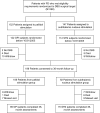Randomized trial of deep brain stimulation for Parkinson disease: thirty-six-month outcomes
- PMID: 22722632
- PMCID: PMC3385495
- DOI: 10.1212/WNL.0b013e31825dcdc1
Randomized trial of deep brain stimulation for Parkinson disease: thirty-six-month outcomes
Abstract
Objectives: Our objective was to compare long-term outcomes of deep brain stimulation (DBS) of the globus pallidus interna (GPi) and subthalamic nucleus (STN) for patients with Parkinson disease (PD) in a multicenter randomized controlled trial.
Methods: Patients randomly assigned to GPi (n = 89) or STN DBS (n = 70) were followed for 36 months. The primary outcome was motor function on stimulation/off medication using the Unified Parkinson's Disease Rating Scale motor subscale. Secondary outcomes included quality of life and neurocognitive function.
Results: Motor function improved between baseline and 36 months for GPi (41.1 to 27.1; 95% confidence interval [CI] -16.4 to -10.8; p < 0.001) and STN (42.5 to 29.7; 95% CI -15.8 to -9.4; p < 0.001); improvements were similar between targets and stable over time (p = 0.59). Health-related quality of life improved at 6 months on all subscales (all p values significant), but improvement diminished over time. Mattis Dementia Rating Scale scores declined faster for STN than GPi patients (p = 0.01); other neurocognitive measures showed gradual decline overall.
Conclusions: The beneficial effect of DBS on motor function was stable and comparable by target over 36 months. Slight declines in quality of life following initial gains and gradual decline in neurocognitive function likely reflect underlying disease progression and highlight the importance of nonmotor symptoms in determining quality of life.
Classification of evidence: This study provides Class III evidence that improvement of motor symptoms of PD by DBS remains stable over 3 years and does not differ by surgical target. Neurology® 2012;79:55-65.
Figures
Comment in
-
Turning tables: should GPi become the preferred DBS target for Parkinson disease?Neurology. 2012 Jul 3;79(1):19-20. doi: 10.1212/WNL.0b013e31825dce96. Epub 2012 Jun 20. Neurology. 2012. PMID: 22722627 No abstract available.
-
Randomized trial of deep brain stimulation for Parkinson disease: thirty-six-month outcomes; turning tables: should GPi become the preferred DBS target for Parkinson disease?Neurology. 2013 Jan 8;80(2):225. doi: 10.1212/WNL.0b013e3182804657. Neurology. 2013. PMID: 23296132
-
Randomized trial of deep brain stimulation for Parkinson disease: thirty-six-month outcomes; turning tables: should GPi become the preferred DBS target for Parkinson disease? Author response.Neurology. 2013 Jan 8;80(2):225. Neurology. 2013. PMID: 23424724 No abstract available.
References
-
- Deuschl G, Schade-Brittinger C, Krack P, et al. A randomized trial of deep-brain stimulation for Parkinson's disease. N Engl J Med 2006; 355: 896–908. - PubMed
-
- Follett KA, Weaver FM, Stern M, et al. Pallidal versus subthalamic deep-brain stimulation for Parkinson's disease. N Engl J Med 2010; 362: 2077–2091. - PubMed
Publication types
MeSH terms
LinkOut - more resources
Full Text Sources
Other Literature Sources
Medical
Research Materials

